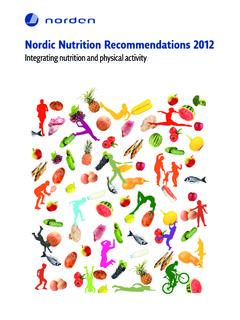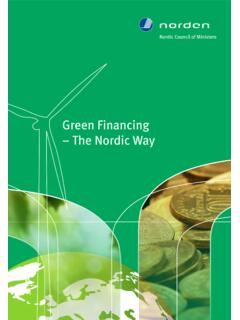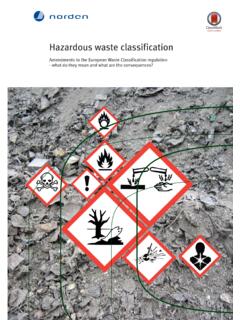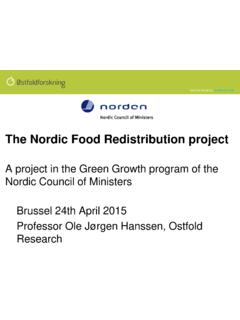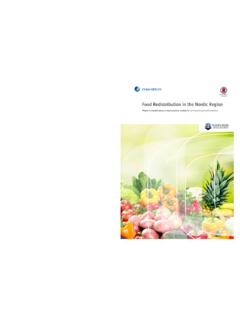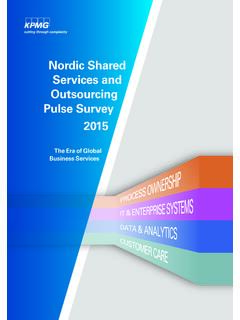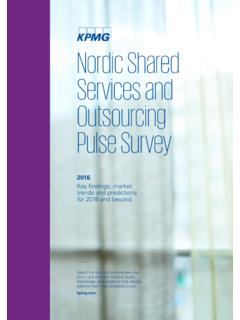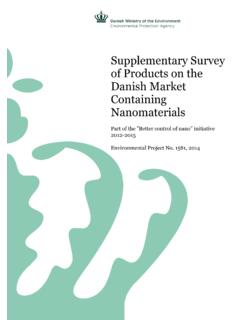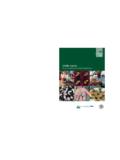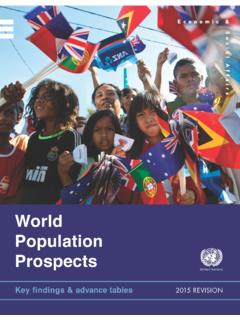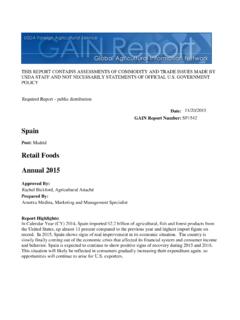Transcription of Ved Stranden 18 Date labelling in the Nordic countries
1 Date labelling in the Nordic countriesPractice of legislationVed Stranden 18DK-1061 Copenhagen report addresses how date labels are determined and applied with focus on reducing food waste in the Nordic countries . This was assessed through a survey and selected interviews with Nordic food manufacturers about their considerations when deciding the date label. Another objective has been to distinguish if there are differences in the way food safety authorities interpret legislation. The results from the study indicate that there are differences between the countries in terms of both the practice of guidelines and the shelf life of food .
2 The report is part of the Nordic Prime Ministers overall green growth initiative: The Nordic Region leading in green growth read more in the web magazine Green Growth the Nordic Way at or at labelling in the Nordic countriesTemaNord 2015 :504 TemaNord 2015 :504 ISBN 978-92-893-3913-1 (PRINT)ISBN 978-92-893-3915-5 (PDF)ISBN 978-92-893-3914-8 (EPUB)ISSN 0908-6692 TemaNord 2015 :504TN2015504 118-02- 2015 10:39:34 Date labelling in the Nordic countries Practice of legislation Hanne M ller, Nina L drup, Pernille Lundquist Madsen, sa Rosengren and Annika Nurttila TemaNord 2015 :504 Date labelling in the Nordic countries Practice of legislation Hanne M ller, Nina L drup, Pernille Lundquist Madsen, sa Rosengren and Annika Nurttila ISBN 978-92-893-3913-1 (PRINT) ISBN 978-92-893-3915-5 (PDF) ISBN 978-92-893-3914-8 (EPUB) TemaNord 2015 :504 ISSN 0908-6692 Nordic Council of Ministers 2014 Layout: Hanne Lebech Cover photo: Formetc Print.
3 Rosendahls-Schultz Grafisk Printed in Denmark This publication has been published with financial support by the Nordic Council of Ministers. However, the contents of this publication do not necessarily reflect the views, policies or recom-mendations of the Nordic Council of Ministers. Nordic co-operation Nordic co-operation is one of the world s most extensive forms of regional collaboration, involv-ing Denmark, Finland, Iceland, Norway, Sweden, and the Faroe Islands, Greenland, and land. Nordic co-operation has firm traditions in politics, the economy, and culture.
4 It plays an im-portant role in European and international collaboration, and aims at creating a strong Nordic community in a strong Europe. Nordic co-operation seeks to safeguard Nordic and regional interests and principles in the global community. Common Nordic values help the region solidify its position as one of the world s most innovative and competitive. Nordic Council of Ministers Ved Stranden 18 DK-1061 Copenhagen K Phone (+45) 3396 0200 Content Content .. 5 7 Foreword ..11 1. Introduction ..13 Background ..13 Goal and scope ..14 2. Legislation ..15 EU legislation of date On-going work.
5 17 Legislation and guidelines in the Nordic countries ..18 Denmark ..18 Finland ..19 Norway ..20 Sweden ..21 3. survey ..23 Purpose and approach ..23 Description of participating companies ..23 Dairy products ..24 Fish products ..25 Meat products ..26 Ready-to-eat foods and ready meals ..27 Summary of results from survey ..28 4. In-depth interviews ..31 Purpose and approach ..31 Results of the interviews ..32 Main findings and comments from the in-depth interviews ..40 5. Discussion ..43 Nordic differences in practice of the food legislation.
6 43 Experiences from other studies ..45 What are the impacts of date labelling for the amount of food waste? ..45 6. Conclusion ..47 7. Further work ..49 8. References ..51 9. Glossary ..53 10. Sammendrag ..55 11. Appendix Country specific results from survey ..59 Results of the Danish companies ..59 Results of the Norwegian companies ..61 Results of the Finnish companies ..63 Result of the Swedish companies ..66 Summary As part of the Nordic Prime Ministers' green growth initiative, The Nor-dic Region - leading in green growth, the Nordic Council of Ministers has initiated a project focusing on reducing food waste in the entire food supply chain.
7 The overall aim was to reduce food waste without endan-gering food safety. The project consisted of three sub projects: 1) Defini-tions and surveys of food waste from primary production, 2) Date label-ling, and 3) Redistribution of food . This report summarizes results from a Nordic project on date labelling and practice of legislations in the Nor-dic countries , phase 1. The project group consisted of representatives from Danish Veteri-nary and food Administration, National food Agency in Sweden, Finn-ish food Safety Authority Evira, Norwegian food Safety Authority, No-fima and Ostfold Research.
8 The project had a project leader from Evira (Finnish food Safety Authority) from the start in august 2013 until April 2014 and then taken over by a Norwegian project leader from Ostfold Research. The goal of the project was to identify how current food labelling leg-islation is practiced in four Nordic countries , find out if there are any differences in how the food safety authorities interpret the legislations, and give guidelines to the food business operators. To study the above raised issues, the following activities were conducted: Compilation of current legislation and guidelines.
9 survey on how the industry determines the date labelling and the shelf life. In depth-interviews with follow-up questions of selected food companies. The same labelling legislation applies throughout the EU and the coun-tries that have an agreement on the European Economic Area (Norway, Iceland and Liechtenstein). The legislation on general labelling and nu-trition labelling is merged to a common regulation on food information to consumers (Regulation (EC) No 1169/2011). The FIC-regulation will enter force in all member states in December 2014.
10 8 Date labelling in the Nordic countries The survey has shown that there are differences in guidelines and how it is practiced. The survey was web-based and 64 companies re-sponded to the survey , representing 87 products (the survey was de-signed so that the companies could add response for more than one product). One of the main questions was how the shelf life is deter-mined. Most of the companies answered that the shelf life of the prod-ucts is determined by Storage experiments in combination with micro-biological and sensory analysis (58%).

